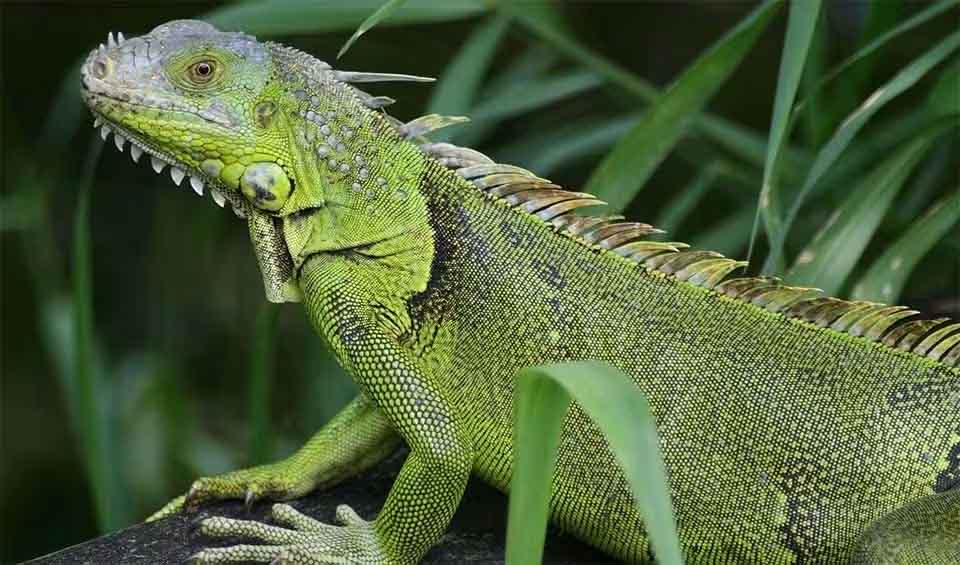This is a large arboreal lizard native to Central America, South America, and parts of the Caribbean. These lizards are renowned for their impressive size, with adults often reaching lengths of up to 1.5 meters (5 feet) from head to tail and some even exceeding 2 meters (6.6 feet).
Despite being called “green” iguanas, they exhibit a kaleidoscope of colors throughout their life. Juveniles generally start out a bright green, which helps them hide in the foliage of their rainforest habitats. As they mature, their coloration can include shades of blue, purple, orange, and yellow, and these colors can change based on factors like mood, health, and temperature. During the breeding season, males can display even more vibrant colors to attract females.
The body of a green iguana is robust and covered in tough, leathery scales. A row of spines running along their back to the tail provides protection from predators and is used in displays of dominance. Their long, muscular tails act as formidable weapons that can deliver painful whips. In a defensive response, green iguanas can also undergo caudal autotomy, a process where they allow their tail to break off if a predator catches them. The tail will eventually regrow, though it may not reach its original length or coloration.
Another distinctive feature of the green iguana is the dewlap, a large flap of skin that hangs from the throat. This dewlap is used in thermoregulation—helping the iguana warm up or cool down by controlling blood flow—and in social signaling during territorial or courtship displays. The dewlap can be extended to make the iguana appear larger and more threatening to rivals or predators.
Distribution
 Anguilla
Anguilla Antigua & Barbuda
Antigua & Barbuda Aruba
Aruba Bahamas
Bahamas Belize
Belize Bolivia
Bolivia Bonaire Sint Eustatius And Saba
Bonaire Sint Eustatius And Saba Brazil
Brazil British Virgin Is.
British Virgin Is. Cayman Islands
Cayman Islands Colombia
Colombia Costa Rica
Costa Rica Curaçao
Curaçao Dominican Republic
Dominican Republic El Salvador
El Salvador Fiji
Fiji French Guiana
French Guiana Grenada
Grenada Guadeloupe
Guadeloupe Guatemala
Guatemala Guyana
Guyana Honduras
Honduras Japan
Japan Martinique
Martinique Mexico
Mexico Montserrat
Montserrat Nicaragua
Nicaragua Panama
Panama Paraguay
Paraguay Peru
Peru Puerto Rico
Puerto Rico Saint Barthélemy
Saint Barthélemy Saint Lucia
Saint Lucia Saint Martin
Saint Martin Saint Vincent
Saint Vincent Sint Maarten
Sint Maarten Spain
Spain Suriname
Suriname Trinidad & Tobago
Trinidad & Tobago US Virgin Islands
US Virgin Islands United States
United States Venezuela
VenezuelaDid you know?
- Green iguanas have excellent vision, enabling them to detect shapes and motions at long distances.
- Green iguanas have a white photosensory organ on the top of their heads called the parietal eye. It is also called the third eye, pineal eye, or pineal gland. This “eye” cannot form images but is sensitive to changes in light and dark and can detect movement. This helps the iguana detect predators stalking it from above.
- Green iguanas have very sharp teeth that are capable of shredding leaves and even human skin.
Anything we've missed?
Help us improve this page by suggesting edits. Glory never dies!
Suggest an editGet to know me
Terrestrial / Aquatic
Altricial / Precocial
Polygamous / Monogamous
Dimorphic (size) / Monomorphic
Active: Diurnal / Nocturnal
Social behavior: Solitary / Pack / Herd
Diet: Carnivore / Herbivore / Omnivore / Piscivorous / Insectivore
Migratory: Yes / No
Domesticated: Yes / No
Dangerous: Yes / No






